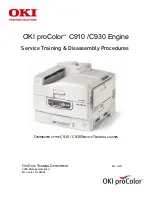
Communications
PcOS Series 90PLUS
Programmer's Guide
Parallel port
Page 138
Rev M
12/16/99
Some systems may wish to change the details of how the strobe, busy, and acknowledge signals interact.
The parallel port option features define how the signals operate. In normal mode, the printer follows the
standard (Centronics) parallel port conventions. With Options 1 and 3, the acknowledge and busy signals
change at the same time. This is sometimes referred to as “ack-after-busy.” Options 2 and 3 force busy
high on the rising edge of the strobe. This is sometimes referred to as “busy-while-strobe timing.” In all
cases, the data is latched on the rising edge of the strobe. In most cases, the normal timing mode will give
the best and most universal results.
DATA
Pins 2-9
STRO BE
Pin 1
BUSY
Pin 11
ACK
Pin 10
Data
Data
Options
1 and 3
Options
2 and 3
Normal
Normal
Figure 25
8.2.2
Printer Buffer Size
The Series 90PLUS Printer has a configurable buffer size. It can be set from 256 bytes to 6144 bytes. The
configurable buffer allows an application to control how far ahead the buffer gets from the printer. The
smaller the buffer, the tighter the control will be. It is up to the application developer to select the optimal
buffer size.
8.2.2.1
One-line Mode
The Series 90PLUS Printer supports a one-line mode of operation. In one-line mode, the input buffer
is set to 1024 bytes; however, the printer will go busy after every [CR] received by the printer. In one-
line mode, the printer will stay busy after the [CR] is received and remain busy until the previous
information is printed.
There are several features that must be considered when using one-line mode. The printer only looks
at [CR]’s. [LF]’s will cause the printer to print but will not set busy. If a [CR] character is received as
part of another command, i.e. as part of graphic data, the printer will go busy after the [CR] is
received, but will go ready after the [CR] is processed. By definition, one-line mode is slow. The
printer will not allow the application to get ahead of the printer.
8.2.3
Parallel Port Inquire IEEE 1284
The Series 90PLUS Printer supports the IEEE 1284, bidirectional, parallel-peripheral interface standard.
This standard provides for a bidirectional link on the parallel port. The Series 90PLUS Printer only
supports Modes 0 and 4, which provide a nibble mode reverse channel for printer identification and status
inquire commands. It is beyond the scope of this guide to describe the IEEE 1284 protocol. The complete
specification is available from the Institute of Electrical and Electronic Engineers, Inc., 345 East 47th
Street, New York, NY 10017, USA.
Summary of Contents for PcOS series 90plus
Page 1: ...P OS c SERIES 90PLUS Receipt Validation Journal Printers PROGRAMMER S GUIDE Rev M PN 100 7586 ...
Page 2: ......
Page 6: ...PcOS Series 90PLUS Programmer s Guide Page iv Rev M 12 16 99 ...
Page 139: ...Programmer s Guide PcOS Series 90PLUS Product Self Tests 12 16 99 Rev M Page 127 73 Italian ...
Page 179: ......
Page 180: ...INSERT PN 100 7307 Rev M 12 16 99 ...
















































